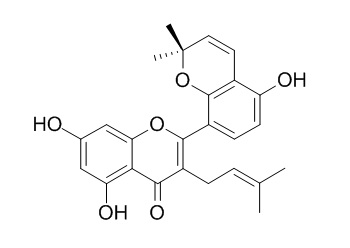Kuwanon A
Inquire / Order:
manager@chemfaces.com
Technical Inquiries:
service@chemfaces.com
Tel:
+86-27-84237783
Fax:
+86-27-84254680
Address:
1 Building, No. 83, CheCheng Rd., Wuhan Economic and Technological Development Zone, Wuhan, Hubei 430056, PRC
Providing storage is as stated on the product vial and the vial is kept tightly sealed, the product can be stored for up to
24 months(2-8C).
Wherever possible, you should prepare and use solutions on the same day. However, if you need to make up stock solutions in advance, we recommend that you store the solution as aliquots in tightly sealed vials at -20C. Generally, these will be useable for up to two weeks. Before use, and prior to opening the vial we recommend that you allow your product to equilibrate to room temperature for at least 1 hour.
Need more advice on solubility, usage and handling? Please email to: service@chemfaces.com
The packaging of the product may have turned upside down during transportation, resulting in the natural compounds adhering to the neck or cap of the vial. take the vial out of its packaging and gently shake to let the compounds fall to the bottom of the vial. for liquid products, centrifuge at 200-500 RPM to gather the liquid at the bottom of the vial. try to avoid loss or contamination during handling.
Journal of Functional Foods2024, 116:106186
Int J Mol Sci.2022, 23(21):13406.
Foods2023, 12(23), 4342.
Pharmaceutics.2022, 14(12):2765.
Chin J Appl. Physiol.2019, 35(3):283-288
J Liq Chromatogr R T2018, 41(12):761-769
J Ginseng Res.2023, 47(4):593-603.
Int J Mol Sci.2019, 20(21):E5488
Eur J Pharmacol.2023, 951:175770.
J of l. Chroma.&Related Tech2020, 43(11-12):414-423.
Related and Featured Products
Chemical & Pharmaceutical Bulletin, 2008 , 26 (5) :1453-8.
Studies on the constituents of the cultivated mulberry tree. III. Isolation of four new flavones, kuwanon A, B, C and oxydihydromorusin from the root bark of Morus alba L[Reference:
WebLink]
The structures of four new flavone derivatives, Kuwanon A, kuwanon B, kuwanon C and oxydihydromorusin were isolated from the benzene extract of the root bark of the cultivated mulberry tree (a variety of Morus alba L.), and were shown to be I, II, III and IV, respectively, on the basis of spectroscopic and chemical evidences.
CONCLUSIONS:
Photooxidative cyclization did not occur with I but with II leading to the formation of a hydroperoxide possessing a dihydrooxepin ring. III was cyclized on photooxidation as II and was converted to morusin (V) by treating with DDQ. On hydration with methanolic hydrochloric acid, V was converted to IV.



